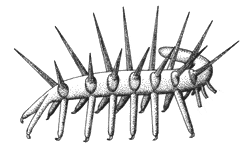"Ecological Services" Exposé (ESE)
|
At the beginning of one class, each of you will be responsible for giving a 2-3 minute exposé
about the "ecological services" provided by a particular group of invertebrates. Do NOT give an exposé
about the biology of your group; instead you should be prepared to discuss informally how humans benefit from
(indeed rely upon) the "flows of materials, energy, and information derived from natural capital stocks."
Use of visual aids (e.g., overhead or shortie Power Pt.) is strongly recommended. Please note that the
date you select will be the earliest day for your exposé--but it could be later to allow
for flexibility in classroom discussions on preceding topics.
|
Please do not make any pencil or pen marks or highlightings in any of the reading
assignments.
Students will be charged for any damage done to classroom materials!
|
1: Briggs, D.E.G. 1991. Extraordinary fossils. American Scientist, 79:130-136; OR READ: Briggs, D.E.G. 2003. Exceptionally preserved fossils, in Briggs & Crowther:328-332. 2: Newton & Laporte. Chapter 4--Organisms and environments:57-80. 3: Dodd & Stanton. [Chapter 7]--Taphonomy:223-252; SCAN:252-276.
4: Awramik, S.M. 1981. The pre-Phanerozoic biosphere - three billion years of crises and 5: Walter, M.R. 2003. Stromatolites, in Briggs & Crowther:376-379. 6: Fedonkin, M.A. 1990. Precambrian metazoans, in Briggs & Crowther:17-24. 7: Levinton, J.S. 1992. The big bang of animal evolution. Sci. American, 267:84-91. 8: Boardman, Cheetham & Rowell. Chapter 12--Annelida:194-204.
9: Morris, S.C. 1989. Burgess Shale faunas and the Cambrian explosion. Science, 246:339-346; 10: Erwin, D.H. 2003. Metazoan origins and early evolution, in Briggs & Crowther:13-21. 11: Hallock, P. 1985. Future farmers of the sea. Natural History, 3:60-67. 12: Wood, R.A. 2003. Evolution of reefs, in Briggs & Crowther:57-62.
13: James, N.P. and Macintyre, I.G. 1985. Carbonate depositional environments, Part I: reefs.
14: Sepkoski, J.J., Jr. and Sheehan, P.M. 1983. Diversification, faunal change, and community
15: Stanley, S.M. 1968. Post-Paleozoic adaptive radiation of infaunal bivalve molluscs- a 16: Ward, P.D. 1982. Nautilus: have shell, will float. Natural History, 91:64-69.
17: Linsley, R.M. 1978. Shell form and the evolution of gastropods. American Scientist,
18: Ausich, W.I. and Bottjer, D.J. 1991. History of tiering among suspension feeders in the |
 |
Back to 315 Syllabus |
|
http://classes.colgate.edu/csoja/geol315/ |